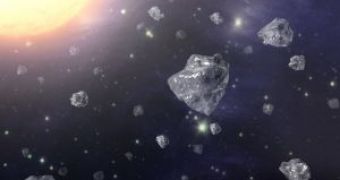Mining diamonds from Earth's crust is a messy business, especially if you consider that they are rather rare on the surface. Scientists predict that larger amounts of diamonds may be found in our planet's inner regions where they usually form; however, the enormous pressure inside the Earth and the great depth prevents us from mining them out. NASA, on the other hand, says that we don't need to look for diamonds on Earth, we can find them in one of the most unlikely places in the universe. Space.
Yes, space is packed with massive amounts of diamonds scattered throughout its immensity. Don't get too excited though, they won't fall from the sky in your hands any time soon, so forget about getting rich that way! Most of these diamonds are extremely small, thousands of times smaller than even a grain of sand, a nanometer in diameter. This new theory is proposed by a group of scientists from NASA's Ames Research Center and is based on observations conducted with the ultra-sensitive Spitzer Infrared Space Telescope.
The first proposal that space may be filled with a significant amount of diamonds came in the 1980's when scientists studying meteorites that fell towards the surface of the Earth realized that multiple meteorites remnants that survived the entry into the atmosphere contained relatively high amounts of nano-size diamonds. A subsequent study showed that as much as three percent of the whole carbon contents of a meteorite remnant that fell onto Earth was in the form of diamonds.
The mystery is why haven't we been able to spot these high amounts of diamonds before? Computer simulations clearly show that they are out there, but the fact is that space observations only twice were able to make direct observations. According to Charles Bauschlicker, the problem was that astronomers simply didn't have enough information related to their distinct fingerprint to filter them out of the massive amount of data collected from space.
Bauschlicher set to finding such signature by creating detailed models of the conditions experienced by matter in interstellar space. Simulations revealed that Spitzer is ideal for making such observations since space diamonds emit bright infrared light in the 3.4 to 3.5 microns and 6 to 10 microns. The light received by the nano-diamonds from nearby stars gets refracted multiple time through the diamond crystals before being re-emitted into space, in the infrared spectrum.
A second problem related to detecting the signature of nano-diamonds in space would be that astronomers were just looking in the wrong area of space, where the diamond concentration is lower or simply haven't been using the proper tools for such studies. Diamonds are allotropes of carbon, consisting of atoms of carbon tightly packed in an extremely stable form. It is still the hardest material known to man, registering a factor of 10 on the Moss hardness scale. This special configuration give the diamond crystal the ability to take ultraviolet light and convert it to produce a distinctive infrared light fingerprint, meaning that, in order to detect nano-diamonds into space, astronomers usually need to look in the vicinity of a hot star, emitting high levels of ultraviolet light.
While in Earth's inner regions diamonds are formed in extreme temperature and pressure conditions, in space nano-diamonds form in rather different conditions. First of all, the pressure in space in close to zero, well under the pressure of our planet's atmosphere, which, even though we are not generally aware of in every day activities, is simply massive. Secondly the temperature in Earth's core may exceed 5000 degrees Celsius. Again, the temperature in space can drop well below -240 degrees Celsius.

 14 DAY TRIAL //
14 DAY TRIAL //